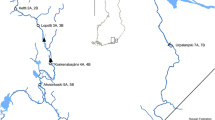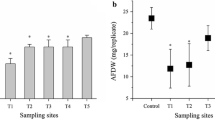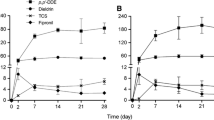Abstract
Purpose
Planarians are increasing in relevance for ecotoxicological research. One of the advantages of using planarians as test animals is the possibility of evaluating a vast range of endpoints, encompassing neurotoxic, tumorigenic, teratogenic, or behavioural responses to stressors. Yet, the possibility of using planarians as predators in studies dealing with the trophic transfer of contaminants has not been explored. Given their epibenthic nature, planarians can be especially useful to evaluate the transfer of pollutants present in sediments, through benthic prey invertebrates.
Materials and methods
In this work, we exposed the Diptera Chironomus riparius larvae (prey) and Tricladida Girardia tigrina (predator) to sediments spiked with benzo[a]pyrene (B[a]P) and evaluated contaminant uptake into both species. Moreover, the dietary transfer of B[a]P-equivalents from larvae to unexposed planarians was assessed.
Results
Both planarians and chironomids exposed to contaminated sediments had detectable amounts of B[a]P-type compounds in their tissues, indicating that B[a]P was bioavailable to these organisms. In the dietary experiment, planarians fed on contaminated larvae, and the results suggest potential trophic transfer of B[a]P-equivalents from prey to predators.
Conclusions
These results indicate that planarians have the potential to be used in ecotoxicity studies using contaminated sediments, as well as in trophic transfer studies as invertebrate predators. Further studies should be focused on the consequences of such tropic transfer in predator performance.


Similar content being viewed by others
References
Aas E, Beyer J, Goksoyr A (2000) Fixed wavelength fluorescence (FF) of bile as a monitoring tool for polyaromatic hydrocarbon exposure in fish: an evaluation of compound specificity, inner filter effect and signal interpretation. Biomarkers 5:9–23. https://doi.org/10.1080/135475000230505
Alegbeleye OO, Opeolu BO, Jackson VA (2017) Polycyclic aromatic hydrocarbons: a critical review of environmental occurrence and bioremediation. Environ Manage 60:758–783. https://doi.org/10.1007/s00267-017-0896-2
Almeida JR, Gravato C, Guilhermino L (2012) Challenges in assessing the toxic effects of polycyclic aromatic hydrocarbons to marine organisms: a case study on the acute toxicity of pyrene to the European seabass (Dicentrarchus labrax L.). Chemosphere 86:926–937. https://doi.org/10.1016/j.chemosphere.2011.10.059
Alvarado AS (2006) Planarian regeneration: its end is its beginning. Cell 124:241–245. https://doi.org/10.1016/j.cell.2006.01.012
Arienzo M, Donadio C, Mangoni O et al (2017) Characterisation and source apportionment of polycyclic aromatic hydrocarbons (pahs) in the sediments of gulf of Pozzuoli (Campania, Italy). Mar Pollut Bull 124:480–487. https://doi.org/10.1016/j.marpolbul.2017.07.006
Armitage PD, Cranston PS, Pinder LCV (eds) (1995) The Chironomidae. Springer, Netherlands, Dordrecht
ASTM (2014) ASTM E729 - 96 (2014) Standard guide for conducting acute toxicity tests on test materials with fishes, macroinvertebrates, and amphibians. American Standards for Testing and Materials, Philadelphia, USA. http://www.astm.org/Standards/E729.htm. Accessed 23 Jun 2015
Barakat AO, Mostafa A, Wade TL et al (2011) Distribution and characteristics of PAHs in sediments from the Mediterranean coastal environment of Egypt. Mar Pollut Bull 62:1969–1978. https://doi.org/10.1016/J.MARPOLBUL.2011.06.024
Beasley G, Kneale P (2002) Reviewing the impact of metals and PAHs on macroinvertebrates in urban watercourses. Prog Phys Geogr 26:236–270
Best J, Morita M (1991) Toxicology of planarians. Hydrobiologia 227:375–383. https://doi.org/10.1007/BF00027626
Borchert J, Karbe L, Westendorf J (1997) Uptake and metabolism of benzo(a)pyrene absorbed to sediment by the freshwater invertebrate species Chironomus riparius and Sphaerium corneum. Bull Environ Contam Toxicol 58:158–165. https://doi.org/10.1007/s001289900314
Brooks AC, Gaskell PN, Maltby LL (2009) Importance of prey and predator feeding behaviors for trophic transfer and secondary poisoning. Environ Sci Technol 43:7916–7923. https://doi.org/10.1021/es900747n
Baguñà J (1976) Mitosis in the intact and regenerating planarian Dugesia mediterranea n.sp. I. Mitotic studies during growth, feeding and starvation. J Exp Zool 195:53–64. https://doi.org/10.1002/JEZ.1401950106
Baguñà J (1974) Dramatic mitotic response in planarians after feeding, and a hypothesis for the control mechanism. J Exp Zool 190:117–122. https://doi.org/10.1002/JEZ.1401900111
Buttarelli FR, Pellicano C, Pontieri FE (2008) Neuropharmacology and behavior in planarians: translations to mammals. Comp Biochem Physiol Part - c: Toxicol Pharmacol 147:399–408. https://doi.org/10.1016/j.cbpc.2008.01.009
Carrasco Navarro V, Leppänen MT, Honkanen JO, Kukkonen JVK (2012) Trophic transfer of pyrene metabolites and nonextractable fraction from Oligochaete (Lumbriculus variegatus) to juvenile brown trout (Salmo trutta). Chemosphere 88:55–61. https://doi.org/10.1016/j.Chemosphere.2012.02.060
Carrasco Navarro V, Leppänen MT, Kukkonen JVK, Godoy Olmos S (2013) Trophic transfer of pyrene metabolites between aquatic invertebrates. Environ Pollut 173:61–67. https://doi.org/10.1016/j.envpol.2012.09.023
Clements WH, Oris JT, Wissing TE (1994) Accumulation and food chain transfer of fluoranthene and benzo[a]pyrene in Chironomus riparius and Lepomis macrochirus. Arch Environ Contam Toxicol 26:261–266. https://doi.org/10.1007/BF00203550
Dissanayake A, Galloway TS (2004) Evaluation of fixed wavelength fluorescence and synchronous fluorescence spectrophotometry as a biomonitoring tool of environmental contamination. Mar Environ Res 58:281–285. https://doi.org/10.1016/j.marenvres.2004.03.072
Filipowicz AB, Weinstein JE, Sanger DM (2007) Dietary transfer of fluoranthene from an estuarine oligochaete (Monopylephorus rubroniveus) to grass shrimp (Palaemonetes pugio): influence of piperonyl butoxide. Mar Environ Res 63:132–145. https://doi.org/10.1016/J.MARENVRES.2006.06.005
Forsthoefel DJ, Park AE, Newmark PA (2011) Stem cell-based growth, regeneration, and remodeling of the planarian intestine. Dev Biol 356:445–459. https://doi.org/10.1016/j.ydbio.2011.05.669
Garcia-Corrales P, Gamo J (1988) Ultrastructural changes in the gastrodermal phagocytic cells of the planarian Dugesia gonocephala s.l. during food digestion (Plathelminthes). Zoomorphology 108:109–117
Jennings JB (1957) Studies on feeding, digestion, and food storage in free-living flatworms (Platyhelminthes: Turbellaria). Biol Bull 112:63–80. https://doi.org/10.2307/1538879
Jennings JB (1962) Further studies on feeding and digestion in Triclad Turbellaria. Biol Bull 123:571–581. https://doi.org/10.2307/1539578
Kainz MJ, Fisk AT (2009) Integrating lipids and contaminants in aquatic ecology and ecotoxicology. Lipids in Aquatic Ecosystems. Springer, New York, New York, NY, pp 93–114
Knakievicz T, Vieira SM, Erdtmann B, Ferreira HB (2006) Reproductive modes and life cycles of freshwater planarians (Platyhelminthes, Tricladida, Paludicula) from southern Brazil. Invertebr Biol 125:212–221. https://doi.org/10.1111/j.1744-7410.2006.00054.x
Leppänen MT, Kukkonen JVK (2000) Effect of sediment–chemical contact time on availability of sediment-associated pyrene and benzo[a]pyrene to oligochaete worms and semi-permeable membrane devices. Aquat Toxicol 49:227–241. https://doi.org/10.1016/S0166-445X(99)00085-5
Leversee GJ, Giesy JP, Landrum PF et al (1982) Kinetics and biotransformation of benzo(a)pyrene in Chironomus riparius. Arch Environ Contam Toxicol 11:25–31. https://doi.org/10.1007/BF01055182
Logan DT (2007) Perspective on ecotoxicology of PAHs to fish. Hum Ecol Risk Assess 13:302–316. https://doi.org/10.1080/10807030701226749
Meador J (2008) Polycyclic aromatic hydrocarbons. In: Jorgensen E (ed) Ecotoxicology. Academic Press, Amsterdam, pp 2881–2891
Mogren CL, Walton WE, Parker DR, Trumble JT (2013) Trophic transfer of arsenic from an aquatic insect to terrestrial insect predators. PLoS ONE 8:e67817. https://doi.org/10.1371/journal.pone.0067817
Newmark P, Alvarado AS (2002) Not your father’s planarian: a classic model enters the era of functional genomics. Nat Rev Genet 3:210–219. https://doi.org/10.1038/nrg759
Noreña C, Damborenea C, Brusa F (2014) Phylum Platyhelminthes. In: Thorp and Covich’s Freshwater Invertebrates: Ecology and General Biology: Fourth Edition. Academic Press, pp 181–203
OECD (2004) Sediment-water chironomid toxicity test using spiked sediment. OECD
Ofoegbu PU, Campos D, Soares AMVM, Pestana JLT (2019) Combined effects of NaCl and fluoxetine on the freshwater planarian, Schmidtea mediterranea (Platyhelminthes: Dugesiidae). Environ Sci Pollut Res 26:11326–11335. https://doi.org/10.1007/s11356-019-04532-4
Ofoegbu PU, Simão FCP, Cruz A et al (2016) Toxicity of tributyltin (TBT) to the freshwater planarian Schmidtea mediterranea. Chemosphere 148:61–67. https://doi.org/10.1016/j.chemosphere.2015.12.131
Oviedo NJ, Nicolas CL, Adams DS, Levin M (2008) Establishing and maintaining a colony of planarians. Cold Spring Harb Protoc 2008:1–16. https://doi.org/10.1101/pdb.prot5053
Palmqvist A, Rasmussen LJ, Forbes VE (2006) Influence of biotransformation on trophic transfer of the PAH, fluoranthene. Aquat Toxicol 80:309–319. https://doi.org/10.1016/J.AQUATOX.2006.09.008
Pickavance JR (1971) The diet of the immigrant planarian Dugesia tigrina (Girard): I. feeding in the laboratory. J Anim Ecol 40:623–635. https://doi.org/10.2307/3441
Pinder LCV (1986) Biology of freshwater Chironomidae. Annu Rev Entomol 31:1–23. https://doi.org/10.1146/annurev.en.31.010186.000245
Schuler LJ, Wheeler M, Bailer AJ, Lydy MJ (2003) Toxicokinetics of sediment-sorbed benzo[a]pyrene and hexachlorobiphenyl using the freshwater invertebrates Hyalella azteca, Chironomus tentans, and Lumbriculus variegatus. Environ Toxicol Chem / SETAC 22:439–449. https://doi.org/10.1002/etc.5620220227
Scoggins M, McClintock NL, Gosselink L, Bryer P (2007) Occurrence of polycyclic aromatic hydrocarbons below coal-tar-sealed parking lots and effects on stream benthic macroinvertebrate communities. J North Am Benthol Soc 26: 694–707. https://doi.org/10.1899/06-109.1
Sheiman IM, Zubina EV, Kreshchenko ND (2002) Regulation of the feeding behavior of the planarian Dugesia (Girardia) tigrina. J Evol Biochem Physiol 38:414–418. https://doi.org/10.1023/A:1021149803009
Shi Z, Tao S, Pan B et al (2005) Contamination of rivers in Tianjin, China by polycyclic aromatic hydrocarbons. Environ Pollut 134:97–111. https://doi.org/10.1016/J.ENVPOL.2004.07.014
Silva C, Oliveira C, Gravato C, Almeida JR (2013) Behaviour and biomarkers as tools to assess the acute toxicity of benzo(a)pyrene in the common prawn Palaemon serratus. Mar Environ Res 90:39–46. https://doi.org/10.1016/j.marenvres.2013.05.01
Simão FCP, Gravato C, Machado AL, Soares AMVM, Pestana JLT (2020) Toxicity of different polycyclic aromatic Hydrocarbons (PAHs) to the freshwater planarian Girardia tigrina. Environ Pollut 266:115185. https://doi.org/10.1016/j.envpol.2020.115185
Szlinder-Richert J, Nermer T, Szatkowska U (2014) PAH metabolites in European eels (Anguilla anguilla) as indicators of PAH exposure: different methodological approaches. Sci Total Environ 496:84–91. https://doi.org/10.1016/J.SCITOTENV.2014.07.037
Vila-Farré M, Rink JC (2018) The ecology of freshwater planarians. Methods in Molecular Biology. Humana Press, New York, NY, pp 173–205
Wilcock RJ, Corban GA, Northcott GL et al (1996) Persistence of polycyclic aromatic compounds of different molecular size and water solubility in surficial sediment of an intertidal sandflat. Environ Toxicol Chem 15:670–676. https://doi.org/10.1002/etc.5620150509
Wu JP, Li MH (2018) The use of freshwater planarians in environmental toxicology studies: advantages and potential. Ecotoxicol Environ Saf 161:45–56. https://doi.org/10.1016/j.ecoenv.2018.05.057
Funding
This study was financially supported by CESAM (UIDP/50017/2020 + UIDB/50017/2020 + LA/P/0094/2020), to FCT/MCTES (Fundação para a Ciência e Tecnologia/Ministério da Ciência, Tecnologia e Ensino Superior) through national funds. We thank FCT and POPH/FSE (Programa Operacional Potencial Humano/Fundo Social Europeu) for the research contract under the program “Investigador FCT” of João L. T. Pestana (IF/01420/2015). FCT also financed a doctoral grant to Fátima C. P. Simão (SFRH/BD/52567/2014).
Author information
Authors and Affiliations
Corresponding author
Ethics declarations
Conflict of interest
The authors declare no competing interests.
Additional information
Responsible editor: Klara Hilscherova
Publisher's Note
Springer Nature remains neutral with regard to jurisdictional claims in published maps and institutional affiliations.
Rights and permissions
About this article
Cite this article
Simão, F.C.P., Campos, D., Soares, A.M.V.M. et al. Presence and potential trophic transfer of benzo[a]pyrene in Chironomus riparius and its predator Girardia tigrina. J Soils Sediments 22, 2309–2316 (2022). https://doi.org/10.1007/s11368-022-03258-0
Received:
Accepted:
Published:
Issue Date:
DOI: https://doi.org/10.1007/s11368-022-03258-0




